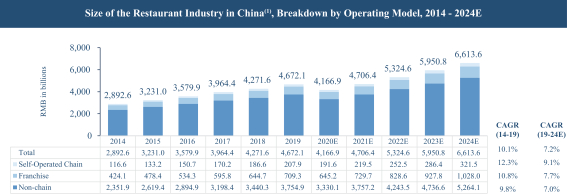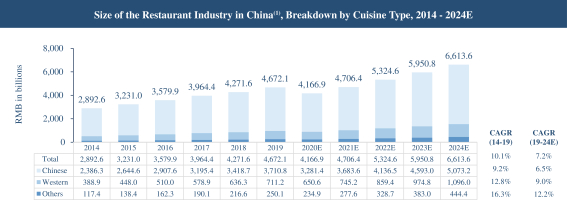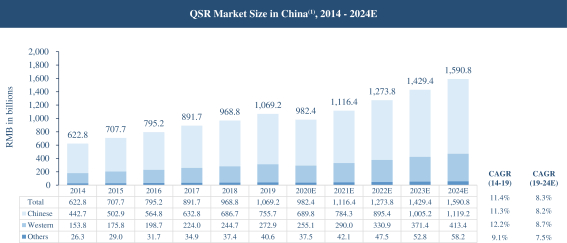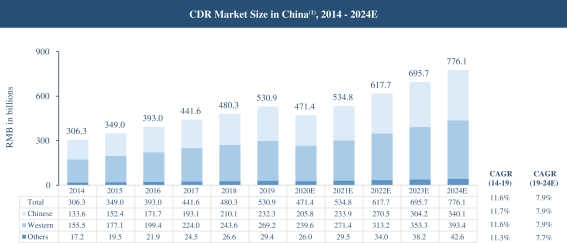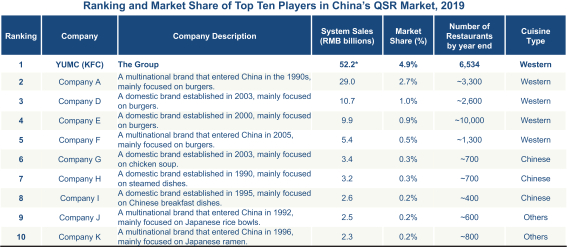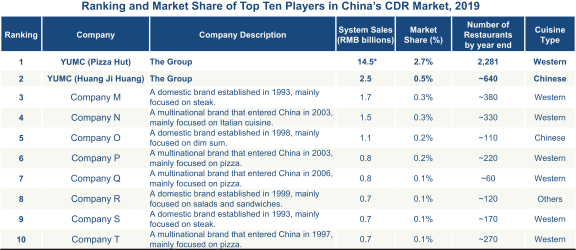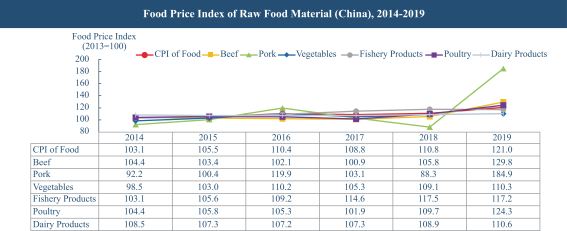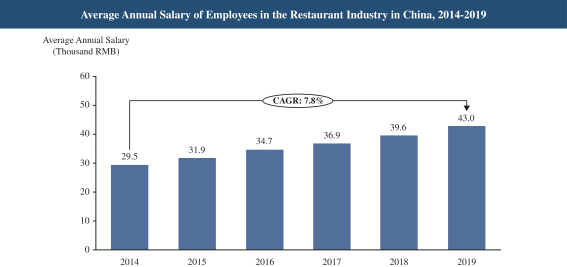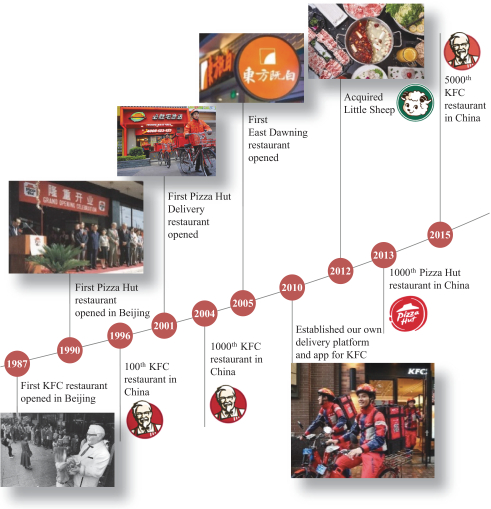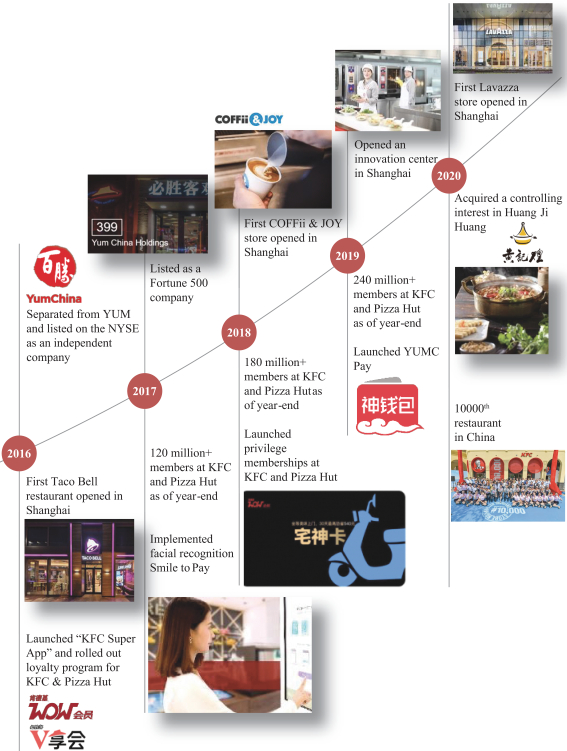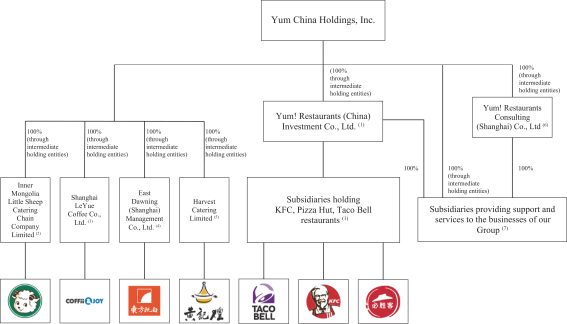RISK FACTORS
We require various approvals, licenses and permits to operate our business and the loss of or failure to obtain or renew any or all of these approvals, licenses and permits could adversely affect our business and results of operations.
In accordance with the laws and regulations of China, we are required to maintain various approvals, licenses permits, registrations and filings in order to operate our restaurant business. Each of our restaurants in China is required to obtain (1) the relevant food business license; (2) the environmental protection assessment and inspection registration or approval; and (3) the fire safety inspection acceptance approval or other alternatives. Some of our restaurants which sell alcoholic beverages are required to make further registrations or obtain additional approvals. These licenses and registrations are achieved upon satisfactory compliance with, among other things, the applicable food safety, hygiene, environmental protection, fire safety and alcohol laws and regulations. Most of these licenses are subject to periodic examinations or verifications by relevant authorities and are valid only for a fixed period of time and subject to renewal and accreditation. We did not obtain these licenses or approvals for a limited number of our restaurants in a timely manner in the past and there is no assurance that we or our franchisees will be able to obtain or maintain any of these licenses.
The operation of our restaurants is subject to the terms of the master license agreement which, if terminated or limited, would materially adversely affect our business, results of operations and financial condition.
Under the master license agreement, we are required to meet a Sales Growth Metric, which is the average annual Gross Revenue (as defined in the master license agreement), for each of the KFC, Pizza Hut and Taco Bell brands for each rolling five (5) calendar year period throughout the term of the master license agreement (“Measurement Period”), beginning January 1, 2017, compared to the calendar year immediately preceding the corresponding Measurement Period (“Benchmark Year”). To illustrate, the first Measurement Period is January 1, 2017 through December 31, 2021 (corresponding to the first Benchmark Year of January 1, 2016 through December 31, 2016) and the second Measurement Period is January 1, 2018 through December 31, 2022 (corresponding to the second Benchmark Year of January 1, 2017 through December 31, 2017).
The requirement regarding Sales Growth Metric will begin upon the end of the first Measurement Period on December 31, 2021. Within sixty days after the beginning of each calendar year following December 31, 2021, and during the term of the master license agreement, we are required to provide a written statement with the calculations of the Sales Growth Metric. If our calculations indicate that any of these restaurant brands failed to meet the Sales Growth Metric (an “SGM Breach”), there is a mechanism under the master license agreement for us to explain and remediate such breach in good faith. YUM has the right to terminate the master license agreement in the event of an SGM Breach. In the event that two consecutive SGM Breaches for KFC, Pizza Hut or Taco Bell, YUM shall be entitled to exercise its right to eliminate or modify the exclusivity of the license granted to us and conduct and further develop the relevant restaurant brand in our licensed territory or license one or more third parties to do so.
The master license agreement may also be terminated upon the occurrence of certain events, such as our insolvency or bankruptcy. We did not have any material breach of the master license agreement during the Track Record Period, and we actively monitor our compliance with the terms of the master license agreement on an on-going basis. Under the master license agreement, we will have the right to cure any breach of the agreement, except for the dissolution, liquidation, insolvency or bankruptcy of YUM China or upon the occurrence of an unauthorized transfer or change of control or other breach that YUM determines will not or cannot be cured. Upon the occurrence of a non-curable breach, YUM will have the right to terminate the master license agreement (or our rights to a particular brand) on delivery of written notice. Upon the occurrence of a curable breach, YUM will provide a notice of breach that sets forth a cure period that is reasonably tailored to the applicable breach. If we do not cure the breach, YUM will have the right to terminate the master license agreement (or our rights to a particular brand). The master license agreement will also contemplate remedies other than termination that YUM may use as appropriate. These remedies include: actions for injunctive and/or declaratory relief (including specific performance) and/or damages; limitations on our future development rights or suspension of restaurant operations pending a cure; modification or elimination of our territorial exclusivity; and YUM’s right to repurchase from us the business operated under an affected brand at fair market value, less YUM’s damages. If the master license agreement were terminated, or any of our license rights were limited, our business, results of operations and financial condition would be materially adversely affected.
Changes in accounting standards and subjective assumptions, estimates and judgments by management related to complex accounting matters could significantly affect our results of operations, financial condition and certain financial ratios.
Generally accepted accounting principles and related accounting pronouncements, implementation guidelines and interpretations with regard to a wide range of matters that are relevant to our business, including revenue recognition, long-lived asset impairment, impairment of goodwill and other intangible assets, lease accounting, share-based compensation and recoverability of deferred tax assets are highly complex and involve many subjective assumptions, estimates and judgments. Changes in these rules or their interpretation or changes in underlying assumptions, estimates or judgments could significantly change our reported or expected financial performance or financial condition. New accounting guidance may require systems and other changes that could increase our operating costs and/or change our financial statements. For example, implementing the new lease standard issued by Financial Accounting Standards Board requires us to make significant changes to our lease management system and other accounting systems, and results in changes to our financial statements. The adoption of the new accounting standard for leases may result in a higher amount of impairment loss on newly recognized right of use assets and negatively impact our results of operations. Upon adoption of Accounting Standards Update (“ASU”) No. 2016-12, Leases (Topic 842) (“ASC 842”) on January 1, 2019, an impairment charge of US$60 million (net of related impact on deferred taxes and noncontrolling interests) on right-of-use assets arising from existing operating leases as of January 1, 2019 was recorded as an adjustment to retained earnings, as the additional impairment charge would have been recorded before adoption had the operating lease right-of-use assets been recognized at the time of impairment. See Note 11 of our quarterly report on Form 10-Q for the quarter ended June 30, 2020 for details on the impairment charge recorded upon adoption of ASC 842 as well as subsequent impairment charges.
In addition, the adoption of ASC 842 may affect certain financial ratios commonly used, such as current ratio1, quick ratio2, and debt to equity ratio3. The recognition of right-of-use assets and lease liabilities expanded our consolidated balance sheets and affected relevant financial ratios. For example, (i) our current ratio and quick ratio decreased as a result of the recognition of the current portion of the lease liabilities; and (ii) our debt to equity ratio increased as a result of the decrease in net assets. Therefore, any future changes in the accounting standards may affect our financial condition, results of operations and certain financial ratios. See Note 2 of Exhibit 99.2 Consolidated Financial Statements for the six months ended June 30, 2020 and 2019 and Note 2 of each of our annual reports on Form 10-K for the years ended December 31, 2019, 2018, and 2017 for details on the impact of all applicable new accounting standards adopted by our Company during the period comprising the three financial years ended December 31, 2017, 2018 and 2019 and the six months ended June 30, 2020.
| 1 | Current ratio equals current assets divided by current liabilities. |
| 2 | Quick ratio equals current assets less inventories and divided by current liabilities. |
| 3 | Debt to equity ratio equals total debt divided by total equity and multiplied by 100%. Debts include all borrowings as well as finance lease obligations. |
- 7 -
